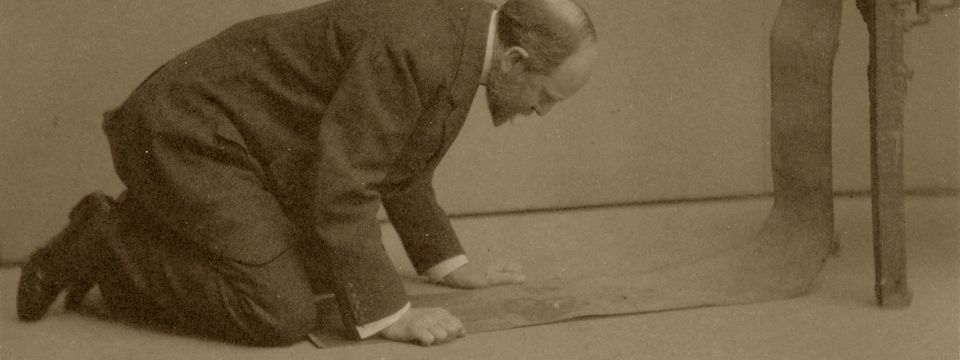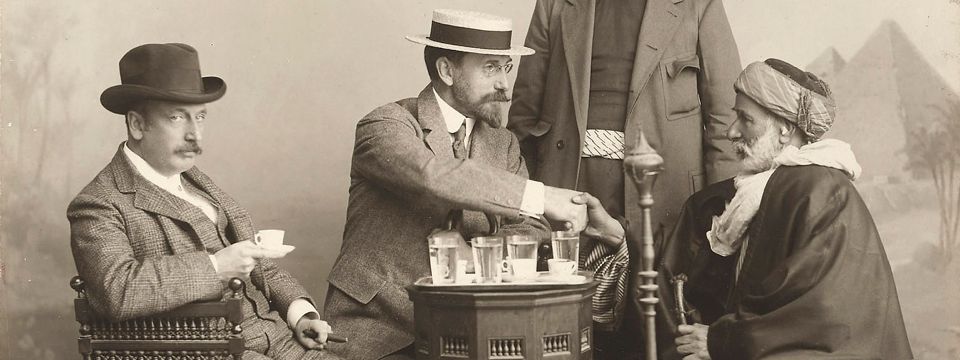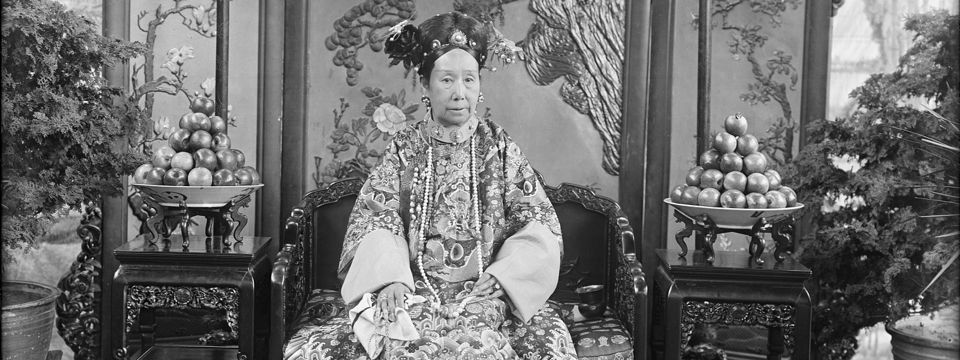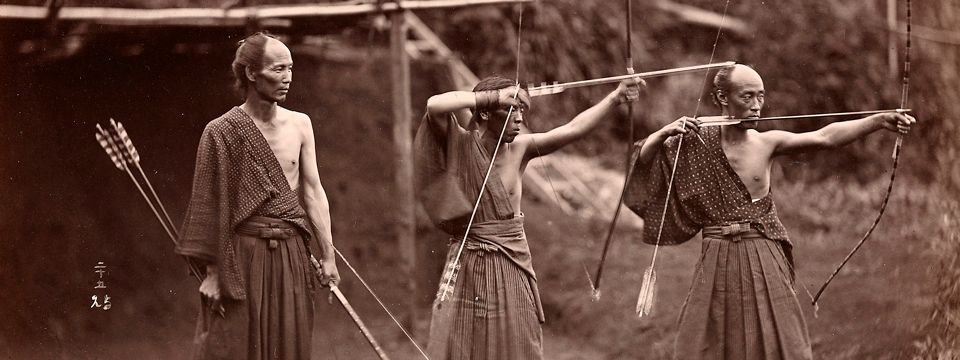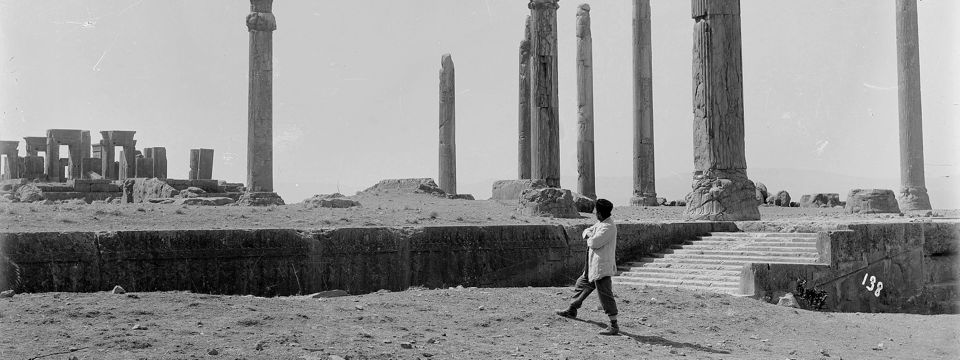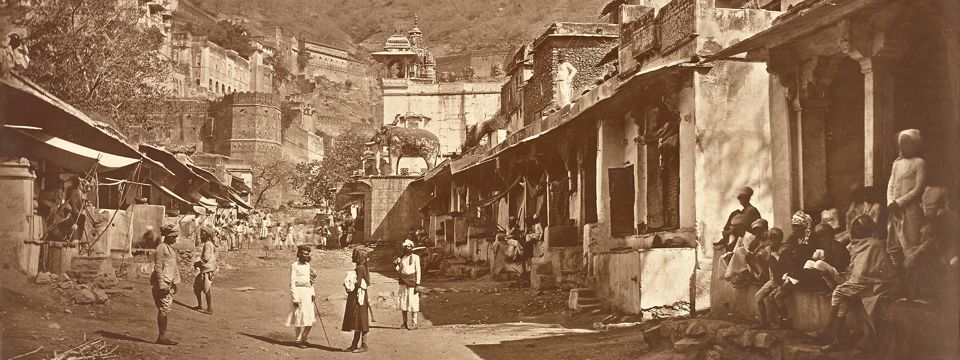Archives Collection Highlights
Our more than 160 collections house a growing number of personal papers, manuscripts, still and moving pictures, graphics, audio tapes, and other forms of documentation.
- Archives Collection Descriptions
- Manuscripts and Papers
- Photography and Graphics
- Smithsonian Collections Blog
Manuscripts and Papers
Supplementing the Charles Lang Freer Papers, the Archives holds personal and professional papers of influential art historians, archaeologists, dealers, collectors and artists. These documents form an important resource for the study of Asian, Middle Eastern, and late nineteenth–century American art.
Charles Lang Freer Papers
The personal papers of Charles Lang Freer (1854–1919), an industrialist and art collector who founded the Freer Gallery of Art, form the nucleus of the Galleries' Archives. They document the pioneering efforts that built one of the great American collections of Asian art and the largest collection of works by American artist James McNeill Whistler (1834–1903) now in a public museum. Papers include Freer’s correspondence with public figures, scholars, dealers, and collectors such as Bunkio Matsuki, Ernest Fenollosa, and Dikran Kelekian, and with artists such as Whistler, Thomas Wilmer Dewing, and Dwight William Tryon. Also included are vouchers documenting Freer's purchases, inventories of his art collection, scrapbooks containing newspaper clippings, travel notes, and diaries. Various Whistleriana, along with Freer's correspondence with Whistler, provides scholars with one of the largest sources of primary documentation about the artist, second only to the holdings of the University of Glasgow's Centre for Whistler Studies. Photographs in the papers document Freer's life, friends and associates, and his travels between 1895 and 1911, primarily to China, Egypt, Italy, and Japan. There are also photographs that Freer acquired during his travels, including a noteworthy group of images of Sri Lanka. Together, these papers form a major resource for ongoing studies of Asian art patronage in the late nineteenth– and early twentieth–century United States.
Dwight William Tryon Papers
The papers of American landscape painter Dwight William Tryon (1849–1925), whose foremost patron was Charles Lang Freer, include correspondence; sketchbooks; newspaper clippings; and portrait photographs of Tryon, his family, and their residences.
Carl Whiting Bishop Papers
An associate curator and associate in archaeology at the Freer Gallery of Art from 1922 to 1942, Carl Whiting Bishop (1881–1942) documented his Gallery–sponsored travels to China from 1923 to 1934. Included in his professional papers are an unpublished two–volume manuscript describing his archaeological research in China, as well as line drawings, rubbings, maps, note cards, and nearly 4,000 glass and film negatives with corresponding original silver prints. These materials document Bishop’s expeditions in northern and central China, illustrating archaeological sites in Henan, Shanxi, and Hebei provinces. Specific digs include the large neolithic site at Wanquan, Shanxi, and sixth century CE tombs near Fenyin. Additional images show Chinese cityscapes, daily life and customs, topography, temples, pagodas, caves, and sculpture.
John Alexander Pope Papers
John Alexander Pope (1906–1982) was associated with the Freer Gallery for almost forty years, serving as director from 1962–1971. His papers include biographical data, photographs, and research files related to his publications on Chinese porcelains.
Ernst Herzfeld Papers
Archaeologist and art historian Ernst Emil Herzfeld (1879–1948) was one of the most widely learned and influential figures in the history of West Asian studies. His professional papers mostly relate to his expeditions to the Near East (chiefly Iran, Iraq, Turkey, and Syria) conducted between 1903 and 1947, in particular his excavations at Samarra, Pasargadae, Persepolis, and Sistan. The papers include correspondence; field notebooks; drawings; sketchbooks; inventories of objects; "squeeze" impressions of architectural details; and approximately 12,000 original photographic images documenting Islamic and pre–Islamic archaeological sites, prehistoric artifacts, monuments, and architecture. Also shown are images of Herzfeld, his sister and colleagues, and twentieth–century life in those regions, including peoples, landscapes, and street scenes.
Myron Bement Smith Collection
Architect and art historian Myron Bement Smith (1897–1970) had a lifelong devotion to West Asia. He accumulated some 87,000 items that are now in the Archives, documenting Islamic art and culture from Spain to India with an emphasis the religious architecture of Iran. Established in 1948 to further an appreciation for Persian art and culture, nearly seventy–five percent of Smith's Islamic Archives consists of his own writings and photographic documentation. His negatives, taken from 1933 to 1947, portray Persian architecture and monuments, in particular the vaulting of the Masjid–i D'Juma at Isfahan, Iran. Other materials in the collection include Smith's personal and professional papers, featuring correspondence, research files, writings, and documentation regarding his 1927–28 Italian and 1933–37 Iranian travels and research.
Smith compiled the remainder of the Islamic Archives from other sources. One of the most significant portions is the photographic material of Antoin Sevruguin, a commercial photographer in Tehran active from the 1870s to 1930. His nearly 800 photographs depict the shahs, royal palaces, military ceremonies, and daily aspects of Persian life. Learn more about Sevruguin below.
Henri Vever Papers
The papers of Parisian jeweler and art collector Henri Vever (1854–1942) provide important documentation about Asian art–collecting in turn–of–the century Paris, as well as research support for the Vever Collection of Islamic paintings, calligraphy, and bookbindings in the Arthur M. Sackler Gallery. Included are six diaries, a ledger of art acquisitions, and photographs. They complement the Vever Family Photograph Album that portrays the Vever family from 1881 to 1930 and the family estate in Noyers, France.
Benjamin March Papers
The development of early coursework in the teaching of Asian art history in the United States is a highlight of the papers of writer, curator, and professor Benjamin Franklin March Jr. (1899–1934), one of the foremost authorities on Chinese art during the 1920s and 1930s. His papers, dating from 1923 to 1935, document his professional and personal life in the United States and China and include lecture notes and outlines, research notes, diaries, and scrapbooks. March was an accomplished and prolific photographer, and his travel albums and fine art prints form an important part of the collection.
John Calvin Ferguson Family Papers
The papers of John Calvin Ferguson (1866–1945), an advisor to the Executive Yuan of the National Government of China, document his life and collecting that began during the turbulent period of the Boxer Rebellion in turn–of–the century China. The papers, portions of which are in Chinese, include personal and professional correspondence, Ferguson's lectures and writings, documents regarding Ferguson's art collecting, a travel diary belonging to his wife Mary Esther, and photographs. The Archives also holds a full–length profile portrait drawing of John Calvin Ferguson by Li Yuling, showing Ferguson in the robes of a Zhou dynasty scholar.
Paul Singer Papers
The papers of medical doctor, neuro–psychiatrist, and art collector Dr. Paul Singer (1904–1997) provide research support for the Paul Singer Collection, the largest single group of Chinese works of art acquired by the Sackler Gallery since it opened to the public in 1987. The papers include biographical data; correspondence; legal and financial material; writings, including his unpublished memoir and draft catalog of the Singer collection; publications; and photographs depicting Singer and his family and friends, early days in Vienna, and collection of Chinese art objects.
Xie Zhiliu Papers
Documents in the papers of Xie Zhiliu (1910–1997) record the extraordinary life of one of China's most esteemed painters and connoisseurs of the twentieth century. The papers, written in Chinese, include biographical data, honorary awards, letters, personal journals, poems, printed material, and seal impressions. Photographs show Xie, his wife and fellow artist Chen Peiqiu, their family, other artists and colleagues, Xie's paintings and works by other artists, historical manuscripts, and cave sites. Also included are writings by Xie, mostly related to his research and publications on artists and on the authentication and identification of Chinese painting and calligraphy in various collections, and Lao Jixiong's manuscript of Dunhuang shiku.
Wang Fangyu Papers
The papers (1942–97) of collector, art historian, and professor Wang Fangyu (1913–1997) mostly relate to his extensive research on the Chinese artist Zhu Da (1626–1705), commonly known as Bada Shanren. Included are letters; notes and writings; publications; photographs of Wang and his friends; and works by Bada Shanren, including forgeries previously attributed to the artist. Mostly written in Chinese, these papers form the single most important documentary resource for the study of Zhu Da's works in the West and complement his paintings in the Freer Gallery of Art.
Yatsuhashi Harumichi Family Papers
The American immigrant experience is illustrated in the papers of art dealer and merchant Yatsuhashi Harumichi (1886–ca. 1981), who moved to the United States in 1907 to work in the Boston branch of the East Asian antiquities company of Yamanaka & Co. The papers, mostly in Japanese, include biographical data; correspondence; a diary; printed material; and portrait photographs of the Yatsuhashi family, Yamanaka Sadajiro, firm employees and their families, the shop interior, and art objects.
"Three Roads to Urga" Typescript
A detailed account, illustrated with 79 silver prints, written after 1918 by Swedish entrepreneur and explorer George Söderbom recalls his years of travel to and in Outer Mongolia along the three caravan routes that led to Urga (now Ulaanbaatar, Mongolia). There are descriptions of travel conditions; modes of transportation; trade practices; the Russian, Mongolian, and Chinese people of this region; daily living; housing; customs and festivals; and animals indigenous to the area.
Kenneth X. Robbins Collection
Psychologist Kenneth X. Robbins assembled this collection to document Princely States India. Included are printed material, philately, and photographs, including a portrait of Maharaja Jaswant Singh of Bharatpur and his court in Durbar, and an album commemorating the silver jubilee of rule by the last Nawab of Gujarat in 1945.
A.W. Bahr Papers
Born in China, Abel William Bahr (1877–1959) was a coal merchant and general importer who later in life became a collector and dealer of Chinese art. His collections have been published in several books and catalogs. Among his papers are numerous notes and drafts of his memoirs, correspondence with other collectors, and photographs of Chinese art objects, from jade to pottery and paintings.
James Cahill Papers
The papers of art historian, curator, and collector Dr. James Francis Cahill (1926–2014) include personal and professional correspondence and project files documenting his many publications, lectures, and activities in the field of Asian art. Documents span his early career at the Freer Gallery of Art, where he served as curator of Chinese art from 1957 to 1965, and his tenure (1965–94) as Professor of the History of Art at the University of California, Berkeley.
Elizabeth Gordon Papers
Elizabeth Gordon (1906–2000) served as editor of the periodical House Beautiful from 1941 to 1964. Her papers from 1959 to 1987 primarily relate to her research regarding the Japanese aesthetic concept of shibui, which resulted in articles published in the August and September 1960 issues of House Beautiful and in the subsequent Shibui Exhibition that traveled to several American museums (1961–64). Correspondence, drafts for articles and lectures, and printed material are included, along with a photo album of exhibition installations and photographs of people, sites, and objects relating to shibui.
Robert O. Muller Papers
Over the course of seventy years Robert O. Muller (1911–2003), an art dealer and collector based in Connecticut, assembled an important collection of Japanese prints from the late 1860s through the 1940s. His personal papers include correspondence relating to Japanese art; files on the 1940 honeymoon he and his wife took to Japan, where he forged many contacts with Japanese artists and art dealers; catalogs; business transactions; magazine and newspaper clippings; photographs; and drafts of an unpublished manuscript.
Ambassador Richard Parker Photographs of Islamic Monuments
This collection of black-and-white prints and negatives of Islamic monuments was taken by former ambassador Richard B. Parker (1923–2011). It includes 200 prints and 481 negatives of Islamic architecture throughout Algeria, Cairo, Lebanon, Syria, Jordan, Morocco, and Spain.
Mehmet Aga-Oglu Papers
Manuscripts and research papers of Islamic art historian Dr. Mehmet Aga-Oglu (1896–1949) largely document his association with the Detroit Institute of Art and the University of Michigan. The collections consist primarily of object photographs and manuscript drafts associated with the research projects of this influential professor and curator of Near Eastern art.
Photography and Graphics
The Archives provides researchers with a rich variety of visual documentation. More than 125,000 photographic items are housed in the Archives, dating from early salt prints of the 1850s to modern ilfochromes of the 1990s, and in formats from early collodion glass plate negatives to hand–tinted lantern slides and film transparencies, albums, and panoramas. Subjects include commercial studio productions, personal travel photography, and court portraiture.
The development of photography paralleled the growing presence of Europeans and Americans in Asia and the Near East, as well as the development of commercial studios. The often–picturesque images of commercial studios are complemented by the documentary photographic output of explorers and scholars working in the Middle East and China during the pre-World War II era. Many of these photographs were received as part of manuscript collections, where they remain in context with accompanying documents. Another important collecting area is commercial graphics, such as postcards and illustrated folios that reflect the diverse visual cultures of Asia, as well as growing fascination with those cultures among the American and European public.
Thomas Daniell Volume and Drawing
This atlas folio contains twenty–four aquatints with descriptive letterpress, produced by Thomas Daniell (1749–1807) in 1803 and titled Oriental Scenery, v. [5], Hindo Excavations in the Mountain of Ellora near Aurungabad in the Decan. Also included is an undated sketch attributed to Thomas Daniell, showing a waterfront scene.
French India Company School Drawings
These watercolors, captioned in French, were created in about 1840 to portray Tamil men and women in various trades and activities. The ethnographic studies may have been rendered by a local Indian artist of the Pondicherry area of South India on commission for a French official or merchant, and are similar to works collectively described as East India Company painting.
Cixi, Empress Dowager of China, 1835–1908, Photographs
Forty–four unique glass plate photonegatives include portraits of Cixi (1835–1908), the Empress Dowager of China. Photographed from 1903 to 1905 by Xunling (1874–1943), the son of the Manchu nobleman and diplomat Yugeng, subjects include Cixi at the Summer Palace (Yiheyuan) and on the imperial barge on Zhonghai just outside the Forbidden City. Cixi wears formal and semiformal attire as well as a costume depicting Guanyin, the Bodhisattva of Compassion. Also depicted are members of the royal court, such as eunuchs, female attendants, and the young Empress Longyu. The photographs were the core of Power|Play, a 2011 exhibition in the Arthur M. Sackler Gallery.
Henry and Nancy Rosin Collection
This extraordinary collection of photographic prints assembled by Dr. Henry D. Rosin and Nancy Rosin depicts nineteenth–century Japan, including prints by commercial studio photographers Felice Beato (ca. 1830–ca. 1906), Baron Raimond von Stillfried (1838–1911), Kusakabe Kinbei (active 1882), and Ogawa Kazumasa (1860–1929). Subjects include architecture, landscapes, formal studio portraits, members of the imperial family, warriors and daily activities, and studio tableaus.
Julia Margaret Cameron Photograph
Two prints by Julia Margaret Pattle Cameron (1815–1879) show a half–length portrait of Christina Spartali (later the Countess Edmond de Cahen). Spartali was the model for Whistler's painting La Princesse du pays de la porcelaine, for which she posed in 1864–65. This collection also includes an albumen print on a cabinet card mount, ca. 1865–70, as well as a photogravure from the same session, printed from the original negative in 1891.
Felice Beato Album Photographs of Delhi
A volume titled Photographs of Delhi, containing thirty–five albumen prints by Felice Beato (ca. 1830–ca. 1906), is mounted into an album format. Captions depict views of the aftermath of the Indian Mutiny near Delhi, India, ca. 1858.
Impey Family Photograph Albums
These personal albums belonged to Captain Eugene Clutterbuck Impey (1830–1904), one of a number of British soldiers to take up photography in India during the 1850s–1860s. E. C. Impey, whose grandfather Sir Elijah Impey and his wife Mary were important patrons of Indian painting, was also related to photographers Sir John Herschel and Julia Margaret Cameron. Comprising two volumes, the albums contain about 300 images, mostly albumen prints with a few salt prints. Depicted are Impey, his family, British colonials, and ethnographic and architectural scenes.
The People of India
Produced in eight volumes between 1868 and 1875, The People of India is a series of photographic illustrations, with descriptive letterpress, of the races and tribes of Hindustan, containing 468 albumen prints by some of the best–known photographers of nineteenth–century India. Although work by commercial firms such as Shepherd & Robertson was included, the majority of the contributors were amateurs such as Willoughby Wallace Hooper (1837–1912), Henry Charles Baskerville Tanner (1835–1898), and James Waterhouse (1842–1922). Prepared by the authority of the government of India, the volumes were edited by Watson and J.K. Kaye, and issued in a limited edition of 200 sets. These had the distinction of being one of the first major ethnographic studies produced by the camera.
The Lucknow Album
This pictorial guide illustrating the city of Lucknow, India, was published in 1874 by the Baptist Mission Press, Calcutta. It was created in part as a memorial to the Garrison of Lucknow and survivors of the rebellion of 1857–58. The volume contains 50 tipped–in albumen prints, accompanied by full textual descriptions of each scene depicted, along with a large–sized plan of the city executed by Parogha Ubbas Alli, assistant municipal engineer, who may have been the photographer.
Antoin Sevruguin Photographs
Antoin Sevruguin (1830s–1933) was a commercial photographer in Iran, whose studio was one of the most successful in Tehran from the 1870s to 1930s. Original glass plate negatives and albumen prints from the Myron Bement Smith Collection include royal portraits of Nasir al–Din Shah and Muzaffar al–Din Shah, and depictions of Iranian society, public events, mosques, and ancient ruins. These images, along with other important Sevruguin photographs in the Smith Collection, provide a rich visual documentation of the later years of the Qajar dynasty (1848–1922) and the early Pahlavi dynasty (1925–41) of Iran. The Sevruguin photographs are the core collection of the Freer|Sackler web feature Iran in Photographs.
The Alice Roosevelt Longworth Collection of Photographs from the 1905 Taft Mission to Asia
Alice Roosevelt, daughter of President Theodore Roosevelt, obtained this collection of photographs and photographic albums when she accompanied the Taft diplomatic mission to Asia in the summer of 1905. The collection includes numerous albums and portraits recording stops in San Francisco, travels on the passenger ship Manchuria, and lengthy visits to Hawaii, Japan, the Philippines, China, and Korea. Also included are three sets of extremely rare portraits of Japanese, Chinese, and imperial rulers gifted to Alice Roosevelt at the time.
Robert J. Del Bontà Collection
These 52 works from the encyclopedic Robert J. Del Bontà collection were the basis for the 2013 exhibition Strange and Wondrous in the Arthur M. Sackler Gallery. The prints and illustrated volumes, dating from the sixteenth to twentieth century, depict how Indian ascetics and Hindu practices became emblems for all that Europeans and Americans found exotic, repulsive, or remarkable in India. By tracing how these images were interpreted and reproduced over time, the collection demonstrates how perceptions of Indian culture shifted through the centuries, from the Enlightenment to the colonial period and Christian missionary movement, and into modernity. Together these prints reveal structures of the European and American imagination as much as they encapsulate conceptions of India.
Individual Still Prints
Among the still prints in the Archives are significant nineteenth–century photographs of Sri Lanka, including images taken by the commercial studios of Scowen & Co. and Skeen & Co. Images of India include works by Samuel Bourne, John Burke, John Murray, Linnaeus Tripe, Francis Frith, Johnston & Hoffman, and Shepherd & Robertson. There are also two studio portraits taken in Istanbul by the Abdullah Bros. in 1860–70. Prints taken in 1870s China by unknown photographers include a view of Beijing from the observatory with seventeenth–century astronomical instruments and a formal portrait showing the Qing dynasty official Duanfang (1861–1911) posed with fellow officials.
Panoramas
- Tsangpo Valley by John Claude White, 1883–1908
- Felix Bonfils panoramic view of Damascus, Syria, ca. 1870
- Felix Bonfils panoramic view of Constantinople, ca. 1870
The Archives houses two panoramas by Felix Bonfils (1831–1885) taken in about 1870. One is a ten–sheet, 360–degree panorama of Istanbul, Turkey, and the other is a five–sheet panorama of Damascus, Syria. Other panoramas include a carbon print in three contiguous sheets of Tsangpo Valley, Tibet, taken in about 1904 by John Claude White, and a panorama of Elphinstone Circle, Bombay, India, ca. 1870s, by an anonymous photographer, comprising four albumen prints mounted contiguously.
Everett Edward Thompson Lantern Slides
The papers of editor, lexicographer, author, and lecturer Everett Edward Thompson (1876–1962) primarily document his 1905 trip to Indonesia and lectures he later delivered (1913–19 and 1956). Obituaries, a portrait photograph dated 1899, portions of a travel journal, announcements and notes, and 132 lantern slides that were assembled for lectures on Indonesia are included.
Raymond A. Hare Photographs
Photographs compiled by Ambassador Raymond A. Hare (1901–1994) document the architecture, cities, and landscapes of the Middle East, including Afghanistan, Egypt, Greece, Iraq, Jordan, Israel and Palestine, Iran, Syria, Turkey, and Yemen. An album of ninety silver-gelatin photographs includes images of minarets in Cairo, Egypt, with captions in Arabic. Two portfolios of photographs presented to Ambassador Hare in 1965 include fifty-two matted images by the photographer Ara Güler and document the art and architecture at the medieval city of Ani.
Hans C. and Sonia P. Seherr-Thoss Photographs of Islamic Architecture
Scholars Hans C. Seherr-Thoss (1912–1992) and Sonia P. Seherr-Thoss (1919–2006) contributed the photographs and negatives they shot circa 1960–68. Hans took the majority of images that appear in their publication Design and Color in Islamic Architecture: Afghanistan, Iran, and Turkey (Smithsonian Institution Press, 1968). Iran, Turkey, Afghanistan, Tajikistan, and Uzbekistan are among the countries photographed.
Online Resources
Herzfeld Resource Gateway
An online resource gateway that consists of all cataloged material from the Ernst Herzfeld Papers.
Sevruguin Resource Gateway
Sevruguin was one of the most successful commerical photographers in Iran.
Alice in Asia Resource Gateway
Photographs from the 1905 Taft Diplomatic Mission to Japan, China, Korea and the Philippines from the collection of Alice Roosevelt Longworth.
Smithsonian Collections Search Center The Smithsonian Institution Research Information System (SIRIS) is a public database with archival and library holdings.
Smithsonian Collections Blog
Posts featuring collections across the Smithsonian's Archives, Libraries, and Special Collections.

